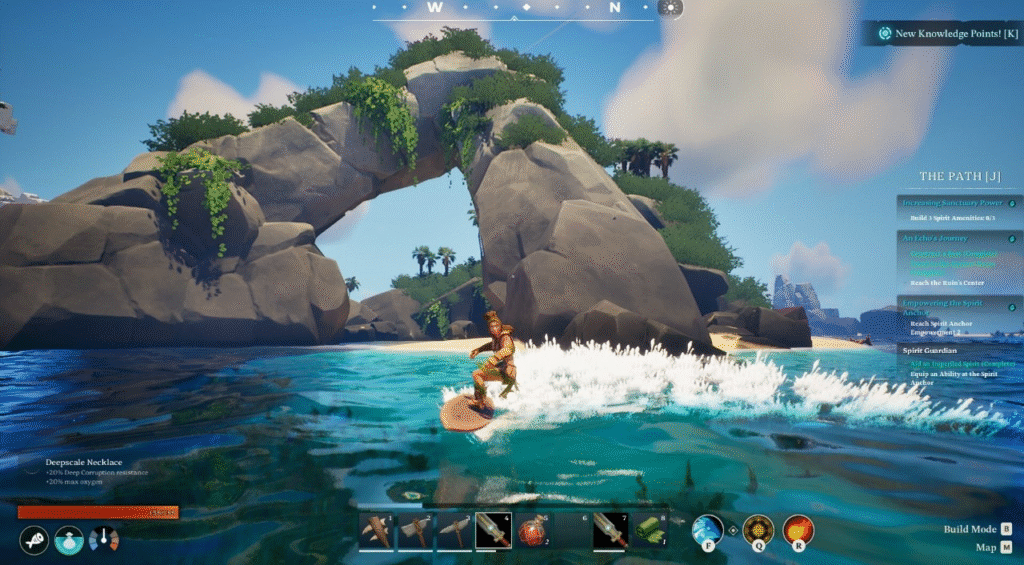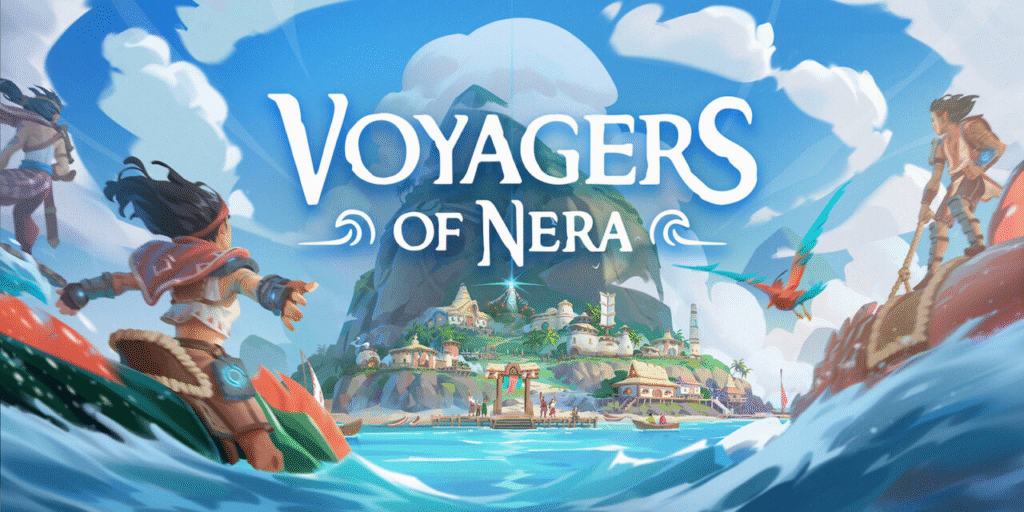Survival crafting games have become one of the most crowded genres in recent years. From Valheim to Enshrouded to the endless stream of Early Access experiments, it can be hard for a newcomer to stand out. Voyagers of Nera, from Treehouse Games, does exactly that—not by reinventing the wheel, but by mixing familiar mechanics with an enchanting oceanic world, cooperative play for up to ten players, and just enough magical flair to set it apart.
After spending more than a dozen hours exploring islands, skimming across waves, and trying to keep a ragtag village of spirits alive, I can safely say: Voyagers of Nera is already one of the most polished and promising survival-crafting games to launch in Early Access this year. But it’s also a game with rough edges, and the long voyage ahead will determine whether it becomes a true classic or sinks into the depths of “good but unfinished” survival titles.

Echoes of a Lost World
In Voyagers of Nera, you play as an Echo—a descendant of the ancient guardians who once protected this ocean world. Nera itself is a breathtaking setting: a vast, magical sea broken up by coral cliffs, lush islands, and the decaying ruins of fallen colossi. It’s a dangerous place, teeming with monsters, but also filled with beauty and mystery.
Your mission is a combination of survival and restoration. Not only must you craft, explore, and fight to keep yourself and your crew alive, but you also have to rescue lost spirits. These fragile beings are hiding from the monsters of the Deep, and when you save them, they reward you with recipes, magical abilities, and even power-ups that reshape your journey.
On paper, it’s a standard survival loop. But the way Treehouse Games ties in the theme of spirits—lost, scattered, and dependent on your care—gives Voyagers of Nera a layer of emotional weight that most survival titles lack. You’re not just building a base for yourself. You’re building a sanctuary for the world itself.
Sailing, Skimming, and Surviving
At its core, Voyagers of Nera is about three things: exploration, survival, and cooperation.
- Exploration: You’ll spend most of your time sailing or skimming across the waves to discover new biomes. Early on, boats are your main means of travel, but the real thrill comes from skimboards and wind-gliding. Skimming across the water at high speed, dodging enemies, and diving beneath the waves to uncover treasure feels fantastic. That said, boats currently feel underdeveloped, and unless you’re coordinating a large crew, skimmers are almost always the better option.
- Survival: Like Valheim, you’ll gather resources, cook meals, and craft gear to survive. Combat is surprisingly responsive, with a mix of melee weapons and elemental spells. Magic, however, needs more depth: the fireballs and lightning bolts you get in the first twenty minutes do most of the heavy lifting for the entire game. Late-game spell variety is lacking, which makes progression feel uneven.
- Cooperation: Nera, at the moment, is designed for up to 10-player co-op, and that’s where it shines brightest. While solo play is possible, everything—from steering ships to managing XP progression—feels better with friends. The roles divide naturally: some people fight, some build, some gather. Unfortunately, XP balance is rough. Resource gatherers gain levels much faster than fighters or builders, which creates a frustrating power gap in co-op sessions.
Despite these flaws, the core loop is engaging. In one 10-hour session, my group of four built a sprawling seaside village, rescued dozens of spirits, and took down several ocean monsters. The combination of sailing to new biomes, unlocking Elder Spirit powers, and upgrading our settlement kept us hooked well into the night.

Building and Progression
The construction system is one of Voyagers of Nera’s biggest strengths. Bases aren’t just survival hubs—they’re sanctuaries that attract and protect spirits. As your village grows, spirits empower your settlement with new abilities and upgrades. It’s a clever loop: protect them, and they protect you.
The building is expressive and flexible. Want to throw together a quick outpost on a cliff? Go ahead. Want to craft a sprawling seaside palace with staircases winding up a fallen colossus? That works too. The system is powerful, but not without frustrations. Framing is clunky and, at times, nausea-inducing with constant flickering. For a game that thrives on creativity, the building tools desperately need smoother handling.
Progression feels solid overall. Resources are plentiful enough to encourage experimentation without bogging you down in grind. That said, late-game variety suffers. Most armor sets are just “+defense” with no real playstyle differentiation, and while trinkets add some spice, nothing stands out as game-changing.
Biomes, Spirits, and Storytelling
Each new biome in Nera offers a mix of danger and wonder: coral cliffs rising into the sky, islands built around fallen titans, and eerie underwater caverns. They’re gorgeous, but after a while, they start to blur together. Zone 3, for example, feels too similar to Zone 2. A little more variety in terrain and environmental storytelling would go a long way.
The spirits themselves are a highlight. Finding them tucked away in dangerous corners, rescuing them from monsters, and watching them settle into your village is genuinely rewarding. Elder Spirits add another layer, granting powerful abilities that reshape how you approach exploration and combat.
The broader story is light so far. Lore stones hint at a deeper history, but the world doesn’t yet reflect that lore in meaningful ways. Seeing remnants of other Echoes—broken camps, final resting places—would help ground the narrative and bring the mystery of Nera to life.
Early Access Performance
For an Early Access launch, Voyagers of Nera is impressively stable. Across 10+ hours, my group encountered only minor bugs: a few awkward animations, occasional collision issues, and clunky UI navigation. Performance is strong, with beautiful visuals and a smooth framerate even during large co-op sessions.
Quality-of-life options are the weakest part of the package. Basic features, such as customizable controls, proper controller support, and sensitivity sliders, are either missing or poorly implemented. These aren’t just nitpicks—they’re modern survival game staples, and their absence is frustrating.
Voyagers of Nera: Voyagers of Nera is one of the cleanest Early Access survival-crafting launches in years. It combines the cooperative spirit of Valheim with the mystical flair of Enshrouded, all set in a vibrant ocean world filled with spirits and secrets. Sailing, skimming, and building with friends is already an absolute blast, and the game has a rock-solid foundation to grow from. But it’s also clear that Nera is unfinished. Magic progression needs more depth, biomes need more variety, XP balance in co-op needs serious tweaking, and the building system demands refinement. If Treehouse Games delivers on these fronts, this could easily become a mainstream hit. As it stands, Voyagers of Nera is a must-play for survival fans, especially if you’ve got a crew of friends ready to dive in. It’s not perfect, but it’s magical, ambitious, and brimming with potential. – Flare


